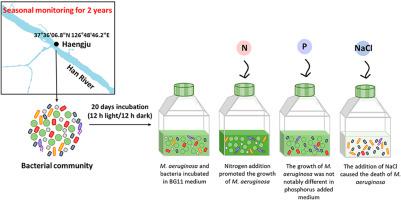Environmental Pollution ( IF 8.9 ) Pub Date : 2020-07-09 , DOI: 10.1016/j.envpol.2020.115198 Minkyung Kim 1 , Jaebok Lee 1 , Dongwoo Yang 2 , Hye Yoon Park 3 , Woojun Park 1

|
DNA-based analyses of bacterial communities were performed to identify the bacteria co-occurring with cyanobacterial blooms in samples collected at a single site over 2 years. Microcystis aeruginosa was the most predominant species (81% in 2018, and 94% in 2019) within the phylum Cyanobacteria, and microcystins were detected during all cyanobacterial blooms. The stereo microscope and scanning electron microscope observations showed bacterial associations on and around the aggregated M. aeruginosa cells. Culture-independent analyses of filtered bacterial communities showed that the Flavobacterium species in phylum Bacteroidetes (19%) was dominant in the cyanobacterial phycosphere, followed by the Limnohabitans species in Betaproteobacteria (11%). Using principal component analysis, major bacterial genus, including Microcystis and Flavobacterium species, were clustered during cyanobacterial blooms in both years. To identify key bacterial species that develop long-term symbiosis with M. aeruginosa, another culture-independent analysis was performed after the environmental sample had been serially subcultured for 1 year. Interestingly, Brevundimonas (14%) was the most dominant species, followed by Porphyrobacter (7%) and Rhodobacter (3.5%) within the Alphaproteobacteria. Screening of 100 colonies from cyanobacterial bloom samples revealed that the majority of culturable bacteria belonged to Gammaproteobacteria (28%) and Betaproteobacteria (57%), including Pseudomonas, Curvibacter, and Paucibacter species. Several isolates of Brevundimonas, Curvibacter, and Pseudomonas species could promote the growth of axenic M. aeruginosa PCC7806. The sensitivity of M. aeruginosa PCC7806 cells to different environmental conditions was monitored in bacteria-free pristine freshwater, indicating that nitrogen addition promotes the growth of M. aeruginosa.
中文翻译:

汉江中与蓝藻水华有关的细菌群落的季节性动态。
进行了基于DNA的细菌群落分析,以鉴定在2年中从单个位置收集的样品中与蓝藻水华同时发生的细菌。铜绿微囊藻是蓝细菌门中最主要的物种(2018年为81%,2019年为94%),并且在所有蓝细菌开花期间均检测到微囊藻毒素。立体显微镜和扫描电子显微镜的观察显示聚集的铜绿假单胞菌细胞周围有细菌缔合。过滤细菌群落的不依赖培养的分析表明,拟杆菌门中的黄杆菌属物种(占19%)在蓝藻属菌圈中占主导地位,其次是LimnohabitansBetaproteobacteria(11%)。使用主成分分析,在这两年中,主要的细菌属(包括微囊藻和黄杆菌属)在蓝细菌开花期间聚集。为了鉴定与铜绿假单胞菌长期共生的关键细菌,在将环境样品连续传代培养1年后,进行了另一种与培养无关的分析。有趣的是,Brevundimonas(14%)是最主要的物种,其次是卟啉菌(7%)和红细菌(3.5%)位于Alphaproteobacteria中。从蓝藻水华样本中筛选出100个菌落后发现,大多数可培养细菌都属于γ-变形杆菌(28%)和β-变形细菌(57%),包括假单胞菌,弯曲杆菌和杆状杆菌。几个分离短波单胞,Curvibacter和假单胞菌种能促进无菌生长铜绿微囊藻PCC7806。在无细菌的原始淡水中监测了铜绿假单胞菌PCC7806细胞对不同环境条件的敏感性,表明氮的添加促进了铜绿假单胞菌的生长。



























 京公网安备 11010802027423号
京公网安备 11010802027423号